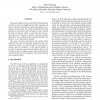Free Online Productivity Tools
i2Speak
i2Symbol
i2OCR
iTex2Img
iWeb2Print
iWeb2Shot
i2Type
iPdf2Split
iPdf2Merge
i2Bopomofo
i2Arabic
i2Style
i2Image
i2PDF
iLatex2Rtf
Sci2ools
ARITH
2003
IEEE
2003
IEEE
Revisiting SRT Quotient Digit Selection
The quotient digit selection in the SRT division algorithm is based on a few most significant bits of the remainder and divisor, where the remainder is usually represented in a redundant representation. The number of leading bits needed depends on the quotient radix and digit set, and is usually found by an extensive search, to assure that the next quotient digit can be chosen as valid for all points (remainder,divisor) in a set defined by the truncated remainder and divisor, i.e., an “uncertainty rectangle”. This paper presents expressions for the number of bits needed for the truncated remainder and divisor, thus eliminating the need for a search through the truncation parameter space for validation. It also presents simple algorithms to properly map truncated negative divisors and remainders into non-negative values, allowing the quotient selection function only to be defined on the smaller domain of non-negative values.
| Added | 04 Jul 2010 |
| Updated | 04 Jul 2010 |
| Type | Conference |
| Year | 2003 |
| Where | ARITH |
| Authors | Peter Kornerup |
Comments (0)

